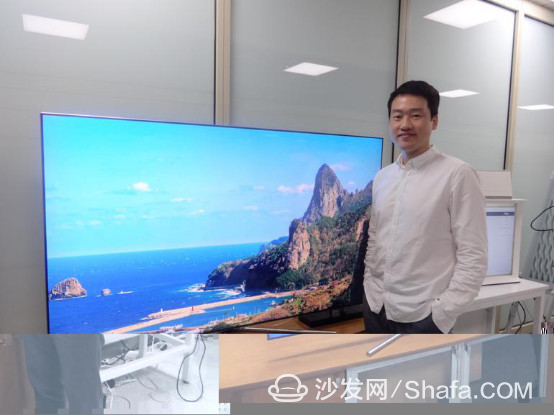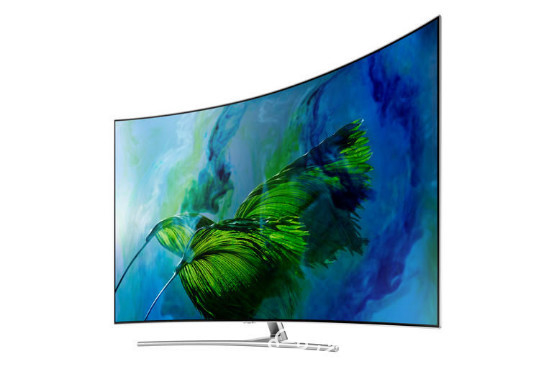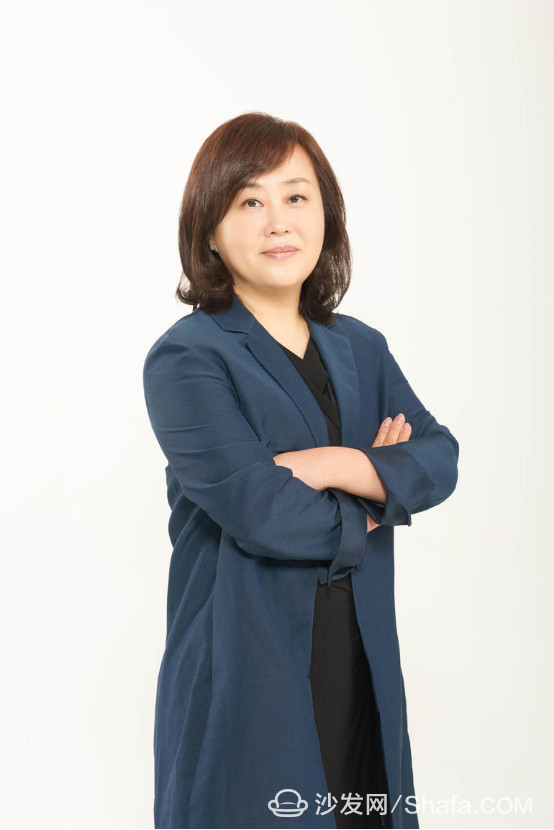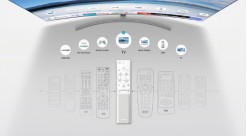
(Samsung Changbae Park believes QLED is the future)
In 2007, Jobs introduced the first generation of the iPhone. Just a year before, Samsung surpassed Sony to become the world's largest LCD TV manufacturer. At the time, Samsung was more famous in the corporate sector because Samsung was a well-known supplier of memory chips. Memory chips haven't received enough attention in the past or in the past. In the mass market, Samsung's popularity is mainly based on slider feature phones, challenging the dominant Nokia and Motorola.
This is a symbolic moment. It stimulates Samsung's growth and gives Samsung confidence. Now that confidence has become Samsung's DNA. Today, only Samsung can compete with Apple in the smart phone market, and its memory chips have also created a lot of cash.
Samsung still ranks first in the TV market. According to Statista's report, Samsung LCD TV accounted for 21.6% of the total in 2016, which is almost twice that of LG and LG only 11.9%. Samsung is also the largest supplier of smart TVs. Samsung's Visul Display (Samsung's own TV department) is proud of this, although the higher profit margins in the mobile and semiconductor sectors have made the television business a little bleak. Once upon a time, Sony dominated the field of CRT television for 35 years. Compared with that period of time, there has clearly been a tremendous change in technology and society in the past 10 years.
Smartphones have emerged over the years. It has changed the way content is consumed and changed consumer expectations. Flat-panel displays are evolving. Samsung is heading towards QLED and has established B2B Display. Not only that, Samsung also embraces AI, big data, and cloud technologies. As new data emerges, new services can change their use when devices are grouped together. For Samsung, global leaders must set new goals and new issues need to be faced.
Samsung believes that consumer expectations are changing. Brighter image rendering screens and data-intensive services have emerged. We are at the dawn of “model conversion,†which will redefine television. Recently, executives at Samsung's Visul Display Division were interviewed by ZDNET about the challenges of Samsung TV.

(Newly Launched Surface QLED TV)
OLED is dead, OLED is the future
Consumers always hope that the connection speed will be faster and the storage capacity will be bigger. Similarly, they also hope that the TV picture will be more realistic. In 2015, Samsung introduced quantum dot (QD) LCD TVs, which at the time were called SUHD, which now became QLED. Changbae Park, senior manager of Visul Display's product strategy team, believes that QLED represents the future.
Just a few years ago, Samsung strongly promoted OLEDs and competed with LG TVs. It seems that OLED is the next big battle. In the TV market, Samsung and LG competed for half a century.
This was indeed the case before Samsung introduced QD LCD TVs, which later changed. In simple terms, QD LCD TVs place the QD film on top of the LCD, providing more accurate color and coverage. Ten years ago, Samsung began to study core technologies around QD materials. In 2013, Sony abandoned QD LCD because it used **, and ** was harmful to the human body. Samsung decided to overcome this defect. In 2010, Sony also abandoned OLED. In 2007, it was the first to introduce OLED TVs.
Parker said: "We think OLED is dead. There are many fundamental problems with OLEDs, such as burn-in. If the TV screen exceeds 65 inches, the problem is even more serious and difficult to overcome. Its brightness is limited and it does not meet the requirements of HDR."
"Choice is not easy or difficult, because you have to do this. If you think about what consumers want, you will find our choice is reasonable." Parker said, "Samsung will never return to OLED, I do not dare to make such an assertion. As a leader, OLED is an unreliable choice, and now is the case, and the future is also."
The use of organic materials for OLEDs has limited screen life and burn-in problems. Parker said: "You ask retailers, they all know that burn screen problem."
QLED uses inorganic materials and is more stable, so there is no such problem. Parker added: "We believe that eventually the OLED camp will turn to QLED and follow our steps."
“Inside, we developed a roadmap. I don’t want to tell you when, but we’re moving towards better technology that is more complex and uses self-luminous quantum dot diodes. It will come more than people expected. Faster."
Afterwards, there is no backlight and the QD material emits light.

brightness
OLED has a key advantage over QLED, which is its black level. Parker admits that OLEDs have higher black levels than QLEDs in dark environments, but most people will not watch TV in dark environments.
Samsung investigated television owners in five countries, including South Korea, the United States, Germany, Mexico, and Vietnam. Samsung asked those who bought the TV within three months and asked them in which environment they would like to watch TV: watching the lights in a brighter environment; watching in a dimly lit environment with adjustable lighting; Watch in a dark, off-light environment.
In Korea, 46.8% of people like to watch in a bright environment, 32% will dim the light, and 21.2% will turn off the light. The United States was 16.4%, 49.6% and 34% respectively. In Germany, it was 17.2%, 56.8%, and 26%; Mexico was 16.8%, 41.6%, and 41.6%, respectively. Vietnam is 46%, 46.8%, 7.2% respectively.
In general, more than two-thirds of ordinary users will turn on the lights, or dim the lights without completely shutting down.
Only when the lights are all off when the OLED's black will be very good, Samsung believes that this advantage is insignificant. The IES (Illuminating Engineering Society) and DIN (German Institute of Standardization) recommend that users adjust the living room to a range of 50-100 lux, and the Korean Standards Committee recommends adjusting it to 150-300 lux.
Parker thinks there is a problem with the current TV test method. The new method requires testing in a dark room, which is almost as dark as a movie theater. He said: “Most consumers watch TV in a bright environment. Can’t professional evaluation methods change?†Some people think that standards should change. Parker is one of them. They think that the evaluation screen should consider the use of users. surroundings.
Samsung has now fully accepted HDR technology. At the beginning of the year, it reached a cooperation with Amazon in the field of HDR10 and is now cooperating with Hollywood to make HDR10 the standard technology for film production.
Parker said: “In the display, broadcast, content, and film industries, people’s interest in HDR is getting deeper and deeper. To make HDR work to its full potential, lifelike quality is the key. Everyone needs a wider color gamut and needs more. The brightness will be higher and higher, the color gamut will be wider and wider, QLED (Samsung said its brightness can reach 2000 nit) is the only technology that can achieve the goal.QLED can also reduce the reflected light to the lowest level, Black will be optimized for viewing in a bright environment."
In 2016, QLED TVs accounted for 6% of Samsung's global shipments. It accounts for 16% of revenue and 27% of profit. The proportion has almost doubled this year. By the end of June, QLED TVs accounted for 10% of shipments, accounting for 23% of revenue and 38% of profits.
Parker said: "Since 2015, the production yield of Samsung quantum dot materials has improved rapidly. Like previous LED TVs, the cost of QLEDs is getting lower and lower, consumers are increasingly like it, and it will eventually become a mass product."
Kim Hyun-suk, president of VD business, is the top leader of Samsung TV business. He said: "We believe that QLED is the future of television and the industry will follow. The current development is fast, and in order to further accelerate the speed, we will keep it good. State, continue to be the world's largest TV manufacturer."

(Sangsook Han and her team believe that smart TV is the content center)
trial
In 2010, for the first time, Samsung put the program store into aggregating television. In the second year, it named the TV as a smart TV. Sangsook Han said: “The program store can be used on mobile phones. We thought at the time: 'Why not have a smart TV?'†said Sangsook Han, vice president of service business team at VD. He said: “In the beginning, we really wanted to develop smart phones. The same TV, I think a lot."
“However, the use of television and the use of smart phones have different expectations, which we do not consider well.†Said Sangsook Han, “This is a learning process. Looking back at that year, I think the trial is worth it. It did not work for Samsung. Bring more profits, but it tells others that we are leaders and want to try something new.â€
From the very beginning, everyone reacted sloppyly to the smart TV. People think that smart TVs are just gimmicks, and their functions are too simple and do not match human-computer interaction. At that time, the demand for smart TVs was not large, much worse than today.
Han said: “Consumers really want to connect to the Internet on TV or use web-based streaming services. People know they need water. The question is whether they need hot or cold water. Is it a bottle or a cup? How can this be achieved? Is the key?"
Samsung continues to experiment. From the very beginning, Samsung only put smartphone features on TV. It created new services that take into account hardware capabilities. Samsung added Family Story, a photo app that allows families to share photos. In 2012, Samsung added a camera to allow users to see their fitness action on the TV. Later, the camera was removed because of privacy violations. In 2013, Samsung launched HiTV, where users can talk to TV, but the conversation is simple. Han said HiTV is ahead of the curve. Unfortunately, these services are short-lived and do not last long.
Han said: "We realize that consumers don't want new things. Really. We also found that television is just watching the media, not using media. TV is more passive and not active. It seems to be a bit behind the gun, but there are indeed such needs: 'I hope there is a calendar on it.' or something like that. It's just that we found that once such a function is implanted, it can't be successful at all."
“We learned some of the most important lessons: First of all, don’t forget the main function of TV. It is the product of watching content. Consumers need media content. Media content is more important than other things. Second, consumers cannot watch TV. As a rule, users will watch more or less on the sofa and look backwards.Many people find it difficult to use the function.If you ask consumers to become more intelligent, then this type of television cannot be called a smart TV. You must allow users to stay where they were originally, not change their use methods and needs. We hope that interactive participation is very easy."

(Samsung has improved UI)
New ideas
In the past 11 years, Samsung has made great improvements to the internal art of television. Not only that, quality, intelligence, design, and appearance have become more important.
Parker of the product strategy team said: "When we are fast followers, it is very easy to do it. We think everything is logical, and we just need to increase the image quality steadily. Now everything needs to be restructured."
"In terms of product strategy, we re-raised the concept. We jumped out of traditional television to see issues and pay attention to new values, which is the new value of television in consumer life. Because of this, we will observe the consumer lifestyle. The shape of the design has been deeply thought, and the final design and appearance will become part of the lifestyle. Now the picture quality is no longer the only concern, but also concerned about the form, care about what TV can do.â€
The reason why Samsung has advanced technology is not natural. In 2006, Samsung surpassed Sony with its Bordeaus TV. The Sony TV's frame design was inspired by the Crystal Spill Cup. Since then, the focus of design has shifted to the shape.
With the advent of curved television, the shape of the TV has changed for the first time. Samsung first installed a curved screen in its flagship product. Just this year, Samsung launched Frame TV, a picture frame TV that can be placed on a table or on a wall.
Han said: “There are many places where Frame is unique, not just appearance. It is also a painting. Users can decorate their houses with TV and turn it into a gallery-like thing because our products are of good quality and have intelligent functions. This idea can become a reality."
In 2015, VD launched the B2B Display business and now pushes QLED Signage. QLED screens can be used as barber shop mirrors. In the Safety Truck concept, Samsung put the screen into the truck, and the rear car could see the front view of the truck on the screen. Huge LED screens are installed in stadiums and movie theaters, and flexible displays are used in prototype products. However, the low yield rate makes the products difficult to use.
"These projects have nothing to do with profits and are related to leadership. We want to build something new, put it into use, and see if they work."
Parker continued: “Samsung has been a television leader for 11 years in a row. This is partly because we are constantly looking for new users. Technology and innovation are very important. These projects are not gimmicks. They are experiments. There are many experiments that failed. But it doesn't matter. The point is that we continue to try and find what consumers want."

(Frame TV is the frame when not in use)
What is TV?
Some people may say that since the 1990s, there has been little change in the function of television besides quality. From Kennedy’s speech on the crisis in Cuba to Simpson’s interrogation, television has always been the “kingdom of the family†and families sit together to watch and learn about new things happening in the world.
Today, smart phones are the main content consumer devices. Samsung is also changing. In the past, it had adopted a TV-centric Internet of Things strategy. Now it wants to balance a variety of devices, including televisions, home appliances, and smart phones, and treat them equally. Samsung has announced that it will add more AI and voice recognition capabilities to home appliances. What will happen to television in the next five years?
Han said: "Today's TV is different from the old TV. In the CRT era, people will watch 3-4 hours of TV. Today's consumers only buy a TV? The TV has different sizes, from 20 inches to 70 inches. Are people enjoying family time just as they have in the past? Is our house the same as in the past? Is it the same way people use TV? When you look at a rapidly changing market, these issues are worth considering.â€
"In the remaining 20 hours, what kind of role the TV will play is what we have to think about. We only have 4 hours a day to watch. We will portray the TV as a screen that can add new features. It can not only be placed in the living room. It can also be placed in unexpected places, used as a window, picture frame, music player, and placed outdoors."

(The line between devices is becoming more and more blurred, and television will enter life in an unexpected form)
"In 5 years, I think TV may not call TV again. It will become a smart device. Don't be wrong. People want to get better picture quality on the big screen. This point has not changed. Everyone's interest Not diminished. About 60% of all TVs today are smart TVs. Monitors and tablets also do what TV does. Devices are aggregated and not aggregated before."
"Services, technologies, and platforms are primarily for one purpose: giving consumers a better experience. This is the key."
Will Bixby be installed in TV next year? Han declined to disclose. Samsung Mobile CTO Injong Rhee said that Bixby will pack devices outside the smartphone. Samsung Mobile Director DJ Koh said that the company will launch Bixby service in China and connect Note 8 to TV. He did not disclose details.
Samsung’s internal communication methods have also changed, Han said. Now that communication is more forward-looking and more positive, it can quickly respond to changes. Take Frame TV as an example, the sensor it installs is manufactured by the semiconductor sector.

(Supply chain management system is the key to Samsung's success)
Han said: "Communication within the enterprise has clearly improved. Consumers have a demand for convergence. We follow demand. 'We must sell television.' Now that the VD department is no longer thinking this way, the department is now more concerned about this issue: 'How functions can help consumers Integrate experience?'"
Samsung attaches great importance to the opinions of consumers. In the first half of this year, VD completed 80 consumer survey projects covering North America, Europe, the Middle East, CIS countries, Southeast Asia, South Korea, China, and India. Samsung also conducted surveys in the form of interviews with focus groups to investigate users' homes.
“What consumer needs are not met and what pain points we have, we want to find the answer. The answer will become the seed and give birth to the prototype product. The prototype product will be lent to the consumer and we will evaluate and see what makes sense for the user’s life. â€
Samsung has extensive experience in supply chain management. In South Korea, Samsung's inventory management system is very famous. Samsung developed a rigorous agreement to inspect the remaining inventory. There are 13 distribution methods for TVs to choose from.
Samsung CEO Kim said: "Consumer behavior is changing rapidly, so I can't say that TV will always be the content center. The test service launched at the beginning of smart TV may be revived, but the way will evolve to reflect the changes in the market."
“We have been leading the television industry for 11 years and will be at the forefront of the future to make a difference for meaningful change.â€
Han said: “In 2018, there was a key word that was emphasized by the company. It was 'individualization.' We also have some important products to launch. It is the result of various business cooperation. TV is no longer a king, and mode changes are within easy reach. TV will play a more important role in the future."
Smart TV/box information can focus on smart TV information network sofa butler (http://), China's influential TV box and smart TV website, providing information, communication, TV boxes, smart TVs, smart TV software, etc. Answering questions.